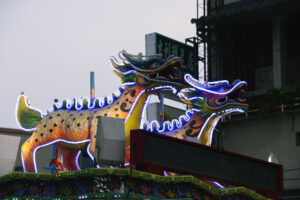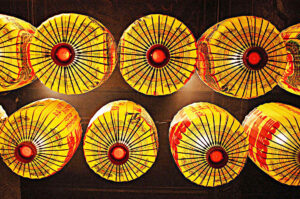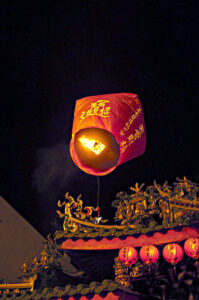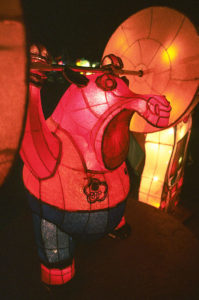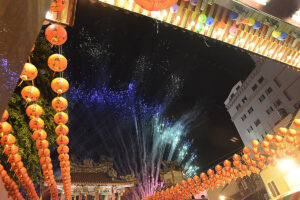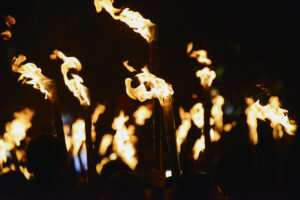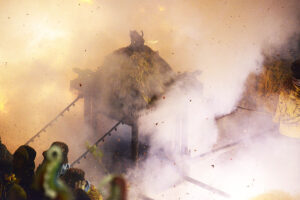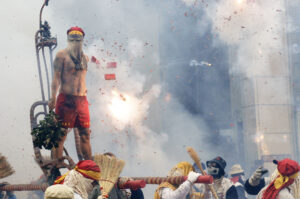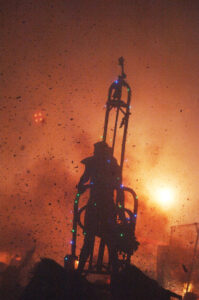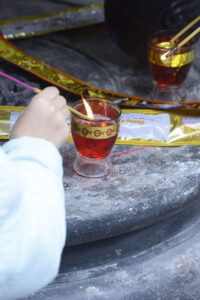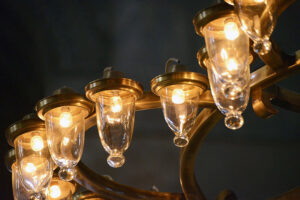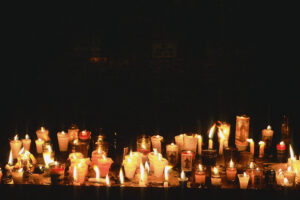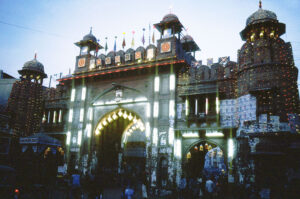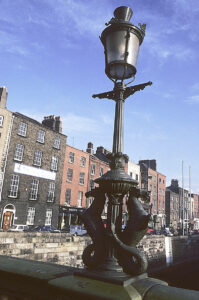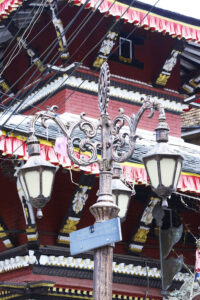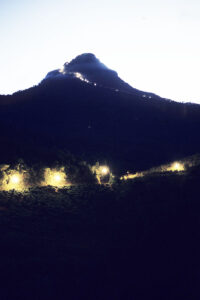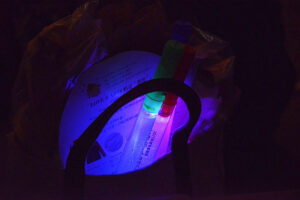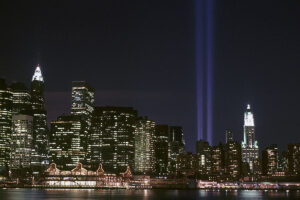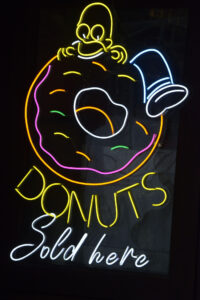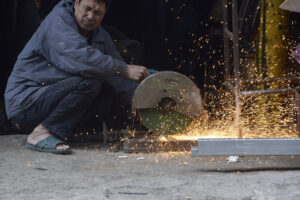Lamps and lights
Colourful fireworks above a temple in Beimen, Taiwan, dedicated to Wang-yeh, the Daoist god of diseases. (Photo copyright © by Kaj Halberg)
The sacred Ganga River (Ganges) is worshipped during Aarthi, a Hindu ceremony held at sunrise or after sunset. In this picture, a prist is swinging a thurible with burning incense at sunrise on the shores of the Ganga, in Varanasi. (Photo copyright © by Kaj Halberg)
Full Moon, rising above Taichung, Taiwan. (Photo copyright © by Kaj Halberg)
Colourful lamps for sale in Kapalı Çarşı (‘Covered Market’), also called Büyük Çarşı (‘Grand Bazaar’), Istanbul, Turkey. (Photo copyright © by Kaj Halberg)
I’m leaning on a lamp,
I know I look just like a tramp,*
Maybe you think I’m hanging ’round to steal a car.
But no, I’m not a crook,
And if you think, that’s what I look,
I’ll tell you why I’m here and what my motives are.
I’m leaning on a lamp-post at the corner of the street,
In case a certain little lady comes by.
Beginning of the song Leaning on a Lamp Post, written by British composer and songwriter Noel Gay, born Reginald Moxon Armitage (1898-1954), first performed in the film Feather Your Nest (1937), sung by actor, singer, songwriter, and comedian George Formby, born George Hoy Booth (1904-1961), often called The Ukulele Man, as he was playing this instrument in most of his performances.
*This version is used in the performance on YouTube. It’s a little different from the version normally shown.
Thus, there is always
A little light in the darkness.
It is out there somewhere, flickering,
But if you want to see it,
You cannot be afraid of the dark.
Translated from the song Et lille lys i mørket (sang til min nabo) (’A little light in the darkness, song to my neighbour’), from the LP En lille bunke krummer (’A little pile of crumbs’, 1978), text and music by Danish singer and composer Trille Bodil Nielsen (1945-2016).
Various forms of illumination are an important issue in most religions. Below, examples from Daoism, Buddhism, Hinduism, and Christianity are shown.
Daoism
Over the years, the dominating religion in Taiwan has become a unique blend of Buddhism and Daoism, with a bewildering array of Daoist gods, which are worshipped on equal terms with the Buddha. Daoism is described in depth on the page Religion: Daoism in Taiwan.
Candles are burning in front of an illuminated image in the Fushing Temple, Xiluo, depicting the Mother God Mazu, the most important deity in Daoism. In the upper picture, temple guardians are seen to the right. (Photos copyright © by Kaj Halberg)
The annual Mazu festival is celebrated with vigour in Taiwan. These pictures were taken during a procession in the town of Shingang. (Photos copyright © by Kaj Halberg)
An image of Mazu is carried in a procession during the Tiger God festival, celebrated in Shingang. (Photo copyright © by Kaj Halberg)
Before entering the inner sanctum of a Daoist temple, burning incense sticks are placed in sand in thuribles, which are often guarded by dragons. When too many incense sticks have been placed in a thurible, a temple servant will collect them and burn them in the centre of the thurible.
Burning incense sticks in the Fushing Temple, Xiluo (upper 2), in a temple in Shingang (3rd), and in a temple in Longjing. (Photos copyright © by Kaj Halberg)
This lamp in a Daoist temple in Beigang, dedicated to the Mother Goddess Mazu, has been blackened by hundreds of years of incense smoke. (Photo copyright © by Kaj Halberg)
Burning fake paper money as an offering is a very common practice in Taiwan. Ovens, serving this purpose, are erected in front of the temples, and many people have a small metal container in front of their home, serving the same purpose.
Burning fake money in ovens in front of temples in Shingang (top), Pitou (2nd), and Changhua. (Photos copyright © by Kaj Halberg)
During a festival for the Tiger God in the town of Shingang, fake money is burned in metal containers. (Photo copyright © by Kaj Halberg)
Sometimes fake money is burned in the open, as here in the town of Pitou. (Photo copyright © by Kaj Halberg)
A very common feature in Daoist temples is traditional paper lanterns, the majority being bright red.
Paper lanterns in a temple, Fengyuan. (Photos copyright © by Kaj Halberg)
Paper lanterns in a temple, Lugang. (Photos copyright © by Kaj Halberg)
In this picture from Ershuei, a dragon is seen on the building in the background. In Chinese mythology, the dragon is a symbol of power, strength, and good luck. (Photo copyright © by Kaj Halberg)
Paper lanterns in the Fushing Temple, Xiluo, dedicated to the Mother Goddess Mazu. (Photos copyright © by Kaj Halberg)
Temple guardian and paper lanterns, Fushing Temple. (Photo copyright © by Kaj Halberg)
Paper lanterns in a Daoist temple, with names of donors attached, Taichung. (Photo copyright © by Kaj Halberg)
Elaborate paper lanterns, adorning a temple in the town of Dajia. (Photo copyright © by Kaj Halberg)
The Chinese zodiac animals have been depicted on these paper lanterns in Dajia. (Photo copyright © by Kaj Halberg)
Qingshui, known locally as Zushi-Gong, is the principal Daoist god worshipped at the Zushi Temple (Chinese Qingshui Zushi Miao), situated in the town of Sanxia, northern Taiwan. This temple is popularly known as the ‘Bird Temple’, due to the numerous depictions of birds on walls and columns, some of which are shown on the page Culture: Folk art in Taiwan.
Paper lanterns in the Zushi Temple, Sanxia. (Photo copyright © by Kaj Halberg)
Temple and paper lanterns, reflected in the windshield of a car, Xiluo. (Photo copyright © by Kaj Halberg)
During Daoist fesivals, and during Chinese New Year, paper lanterns, with well-wishing words painted on them, are released into the air, with a bundle of burning fake money inside.
These pictures were taken during a festival for the Mother Goddess Mazu, celebrated in Changhua. (Photos copyright © by Kaj Halberg)
These were taken during celebration of Chinese New Year 2015 in Xiluo. (Photos copyright © by Kaj Halberg)
Paper lanterns are also seen in other Buddhist countries.
Paper lanterns, Hanoi, Vietnam. (Photos copyright © by Kaj Halberg)
This paper lantern in Hanoi depicts a red-naped crane (Grus japonensis), a large crane, which breeds in Manchuria, Inner Mongolia, and south-eastern Siberia, and on the Japanese island Hokkaido. This species is often depicted in Far East artwork. (Photo copyright © by Kaj Halberg)
Paper lanterns with drawings, depicting dragons, Guizhou Province, China. (Photo copyright © by Kaj Halberg)
During the Taiwanese Lantern Festival, which is celebrated during Chinese New Year, thousands of paper lanterns are displayed. The following pictures were taken in Tainan in the Year of the Rooster (2005), where numerous gigantic lanterns were displayed, depicting various themes, including animals.
Paper lanterns, adorning a bridge. (Photo copyright © by Kaj Halberg)
Paper lanterns, swaying in the wind. (Photo copyright © by Kaj Halberg)
Naturally, a large number of lanterns at this festival depicted roosters, as it was celebrating the start of the Year of the Rooster. (Photo copyright © by Kaj Halberg)
This lantern depicts a tiger. (Photo copyright © by Kaj Halberg)
This one depicts a weight-lifting hippo. (Photo copyright © by Kaj Halberg)
Lanterns, depicting two cats, which resemble Disney’s Aristocats. (Photo copyright © by Kaj Halberg)
These lanterns depict penguins. (Photo copyright © by Kaj Halberg)
Fireworks are always ignited during Daoist festivals.
The following pictures show Chinese New Year celebrations 2015 at the Fushing Temple in Xiluo. Lots of fireworks are ignited, and shortly before midnight, people carry torches, consisting of green bamboo sticks with rolls of burning paper inside, from the temple through the streets of the town, to scare away evil spirits.
(Photos copyright © by Kaj Halberg)
Fireworks, ignited during the Tiger God festival along a street in Shingang. (Photo copyright © by Kaj Halberg)
Lots of fireworks, ignited during the annual Mazu festival, celebrated in Shingang. (Photos copyright © by Kaj Halberg)
Fireworks are often ignited beneath palanquins, which contain images of Daoist gods, carried on bamboo poles, resting on the shoulders of 6 or 8 men. These pictures are from Shingang. (Photos copyright © by Kaj Halberg)
During the Lantern Festival, celebrated in 2014 in the city of Taitung, volunteers undressed to represent Handan-yeh, the Daoist Money God. As he dislikes cold, people would shell the volunteer with firecrackers to heat him up, thus maybe winning his favour. To protect their face, the volunteers were wearing glasses, a hat or a helmet, and a scarf over their mouth and nose, but their naked body was usually burned in numerous places.
Processions in honour of Handan-yeh took place in the morning as well as in the evening. (Photos copyright © by Kaj Halberg)
This illuminated image was carried in a procession during the Lantern Festival in Taitung. (Photo copyright © by Kaj Halberg)
Adorned wagon in a procession during the Tiger God festival, celebrated in Shingang. (Photo copyright © by Kaj Halberg)
A small palanquin with an image of a Daoist god is carried during the same procession, Shingang. (Photo copyright © by Kaj Halberg)
An illuminated image of a deity is carried in a procession during a Daoist festival, celebrated in the town of Madou, near Tainan. (Photo copyright © by Kaj Halberg)
Neon lights in the same procession. (Photo copyright © by Kaj Halberg)
In certain fishing communities in southern Taiwan, people still celebrate the so-called Boat Burning Festival, a Daoist festival, during which a complete wooden boat is built, only to be burned as an offering to the god of diseases, Wang-yeh, hoping that he will spare the people of the plague and other dreadful diseases. In former times, the burning boat was pushed out to sea, ceremonially carrying the diseases away, but this practice has now been abandoned, and the boat is burned on land.
Several pictures from this festival are shown on the page Culture: Boats and ships.
Boat Burning Festival, Jiading, near Kaoshiung. (Photos copyright © by Kaj Halberg)
Illuminated pole with a tiger and a dragon in a Daoist temple on Siao Liouchou Island. (Photo copyright © by Kaj Halberg)
Buddhism
Aspects of the life of the Buddha, and the origin of Buddhism, are described on the page Religion: Buddhism, where you can also read more about the Bodhnath Stupa and the Shwedagon Pagoda below.
This woman is celebrating the Buddha’s birthday by igniting numerous mustard oil lamps at the huge Bodhnath Stupa, Kathmandu, Nepal. (Photo copyright © by Kaj Halberg)
At the giant Buddhist Shwedagon Pagoda in Yangon, Myanmar, red candles are burned to honour the Buddha. (Photo copyright © by Kaj Halberg)
Ignited oil lamps in the Kuan Yin Teng Temple, Georgetown, Penang, Malaysia. (Photo copyright © by Kaj Halberg)
Igniting an oil lamp at the Tran Quoc pagoda, Hanoi, Vietnam. (Photo copyright © by Kaj Halberg)
Oil lamps in the garden around the Tran Quoc pagoda. (Photo copyright © by Kaj Halberg)
These lamps, carved out of gourds, were for sale in the town of Dongshih, Taiwan.
This lamp has a tiny Buddha inside. The text translates thus: “The Buddha’s light is blessing the World.” (Photo copyright © by Kaj Halberg)
This elaborately carved gourd has been adorned with tassels. (Photo copyright © by Kaj Halberg)
Hinduism
Hinduism is the dominant religion in India, counting for about 85% of the population. This religion is permeated with rituals. Some examples, involving lamps, are shown below, and other Hindu festivals are described on the pages Religion: Hinduism, and Travel episodes – India 1991: Attending Hindu festivals in Rajasthan.
These women place tiny oil lamps and marigolds on small ‘rafts’, made from leaves, presenting them as an offering to the Ganges. (Photos copyright © by Kaj Halberg)
Aarthi is a ceremony, held at sunrise or after sunset, in which the sacred Ganga River (Ganges) is worshipped. During Aarthi, a thurible with burning incense is swung in the air.
In this picture, Aarthi is celebrated at the Ganges after sunset in the city of Varanasi. (Photo copyright © by Kaj Halberg)
Almost all deceased Hindus are cremated. For the sake of the next reincarnation of the deceased, his or her relatives make a great effort to carry out the cremation rituals in a proper way. The oldest son, who is tonsured, ignites the funeral pyre. To increase the chances of the deceased obtaining moksha (a life without desire), the ashes are strewn into a sacred river, preferably the mighty Mother Ganga, or one of her tributaries.
In Kathmandu, Nepal, most cremations take place along the sacred Bagmati River, a tributary to the Ganga. (Photo copyright © by Kaj Halberg)
During the Hindu festival Janai Purnima, thousands of pilgrims are crowding around Muktinath, a very important Vishnu temple in the Mustang District, central Nepal.
This pilgrim is busy igniting mustard oil lamps at the Muktinath Temple. (Photo copyright © by Kaj Halberg)
Ignited oil lamps atop a statue, depicting a Hindu goddess, Kathmandu, Nepal. (Photo copyright © by Kaj Halberg)
Thaipusam is a Hindu festival, which celebrates Subramaniam (‘The Virtuous One’), son of the supreme gods Shiva and Devi. It takes place in the Batu Caves, near Kuala Lumpur, Malaysia. During this festival, pilgrims undergo various self-inflicted pains to repent their sins, or to have their wish fulfilled.
The festival is described in detail on the page Travel episodes – Malaysia 1985: Thaipusam – a Hindu festival.
During Thaipusam, offer fires have been ignited outside the Batu Caves. (Photo copyright © by Kaj Halberg)
Christianity
The rise of Christianity is dealt with on the page Religion: Christianity.
One of Christendom’s most gorgeous buildings is the Byzantine church ‘Church of the Holy Wisdom’ in Istanbul, Turkey, usually called Hagia Sophia, or, in Turkish, Aya Sofia. This grand structure, which was erected 532-537 during the reign of Roman Emperor Justinian, was converted into a mosque in 1453, and today it is a museum.
A collection of chandeliers, adorning the Hagia Sophia. (Photos copyright © by Kaj Halberg)
Lighting candles is a very common practice at Christian shrines, especially in Catholic churches.
The predominant religion in Guatemala is Catholicism. In this picture, candles have been ignited in the San Fransisco Church, Antigua. (Photo copyright © by Kaj Halberg)
Candles in the Catholic Basilique Saint-Sauveur, Dinan, Brittany. (Photos copyright © by Kaj Halberg)
Candles in a Catholic church in the town of Confort-Meilars, Brittany. (Photo copyright © by Kaj Halberg)
Roman Catholics, burning candles at a shrine for Virgin Mary, Cartagena, Chile. (Photos copyright © by Kaj Halberg)
Candles in the Catholic church Notre Dame de Roscudon, Pont-Croix, Brittany. (Photo copyright © by Kaj Halberg)
Illuminated golden cross with the crucified Jesus, St. Dominic’s Church, Oyster Bay, Long Island, United States. (Photo copyright © by Kaj Halberg)
Miscellaneous
In this section, the pictures are arranged in alphabetical order according to country name.
Lighthouses are presented on the page Culture: Towers and spires.
Brunei
The gorgeous Omar Ali Saifuddien Mosque, often just called ‘The Golden Mosque, is located in Bandar Seri Begawan, the capital of Brunei, Borneo. It was named in honour of Omar Ali Saifuddien III, the 28th Sultan of Brunei, who initiated its construction.
Omar Ali Saifuddien Mosque, illuminated in the evening. (Photo copyright © by Kaj Halberg)
China
Street lamps in the town of Weining, Guizhou Province. (Photo copyright © by Kaj Halberg)
Costa Rica
For unknown reasons, this black vulture (Coragyps atratus) is pecking at a street lamp, Cahuita, Limón. This bird is described on the page Animals – Birds: Birds in Costa Rica and Guatemala. (Photo copyright © by Kaj Halberg)
Denmark
Crystal chandelier, dating from the 1700s, Selsø Castle, Zealand. (Photo copyright © by Kaj Halberg)
Reconstructed Middle Age kitchen, Middle Age Centre of Bornholm. (Photo copyright © by Kaj Halberg)
Species of mullein (Verbascum) are known by other names, including torches, referring to the fact that in the old days the long spikes were dried and dipped in tallow to make torches. When dry, the down on leaves and stem makes excellent tinder, and before the introduction of cotton it was used for lamp wicks, hence the popular name candlewick plant.
According to legend, witches used lamps and candles with mullein wicks, giving rise to the name hag’s taper, although hag may be derived from Anglo-Saxon haege or hage (‘hedge’), perhaps implying that the long spike resembled a tall candle, growing in the hedge. The name Our Lady’s candle was also inspired by the shape of the spike.
In his book A niewe Herball (1578), English botanist and antiquary Henry Lyte (1529?-1607) tells us that the “whole toppe, with its pleasant yellow floures, sheweth like to a wax candle or taper, cunningly wrought.” Another herbalist, John Parkinson (1567-1650), says: “Verbascum is called of the Latines candela regia, and candelaria, because the elder age used the stalks dipped in suet to burne, whether at funeralls or otherwise.”
Flowering spikes of dense-flowered mullein (Verbascum densiflorum), photographed on the island of Funen. (Photos copyright © by Kaj Halberg)
Egypt
Columns and statues of Pharaoh Ramesses II, illuminated in the evening, Luxor Temple. (Photos copyright © by Kaj Halberg)
Evening illumination on a tree, Luxor. (Photo copyright © by Kaj Halberg)
Greece
Fishing boats, equipped with lamps to attract fish at night, Kavala. (Photo copyright © by Kaj Halberg)
India
Udaipur is a delightful city in southern Rajasthan, situated around the gorgeous Pichola Lake. As early as the 10th Century, the Hindu Mewar Rajputs established a town here, named Ayad, which became a thriving trading centre.
Udaipur was founded in 1559 during the reign of Maharana Udai Singh II, the ruler of Chittorgarh, further north. Chittorgarh, situated in a flat tableland, was vulnerable to attacks from the Maharana’s enemies, notably Muslims, who had conquered parts of northern India. Following the emergence of artillery warfare in the 16th century, Udai Singh decided to move his capital to a more secure location, choosing Ayad.
However, as Ayad was prone to flooding, he decided to establish his new capital on a ridge east of the Pichola Lake, and to protect the new city from attacks, he ordered a wall, 6 km long and with seven gates, to be built around the city. Today, Udaipur is a treasure trove of Mewar architecture, notably a number of palaces, of which two were built on islands in the lake.
The history of the fierce Rajputs is related on the page Travel episodes – India 1986: “His name is Muhammed!”
Two palaces were built on islands in Pichola Lake. This picture shows Jag Mandir, illuminated by night. (Photo copyright © by Kaj Halberg)
The Moon and coconut palms (Cocos nucifera), just before dawn, Colva Beach, Goa. The Moon is illuminating a small cloud, and together they resemble an old-fashioned street lamp. (Photo copyright © by Kaj Halberg)
Kota Gate, an old city gate in Bikaner, Rajasthan, is illuminated in the evening. (Photo copyright © by Kaj Halberg)
In the evening, the Sun Temple at Konark, Odisha (Orissa), is illuminated. (Photo copyright © by Kaj Halberg)
The Maharaja’s palace in Mysore, Karnataka, also known as Amber Vilas, was constructed 1911-1912 to replace the former palace, which burned down during wedding celebrations in 1896. In 1976, the palace was confiscated by the state, and in 1998 the Maharaja’s family was turned down when they requested compensation. However, the family still lives in parts of the palace.
Once a week, Amber Vilas is illuminated in the evening by about 50,000 light bulbs. (Photos copyright © by Kaj Halberg)
Ireland
Street lamp on a bridge, spanning the An Life (Liffey) River, Dublin. (Photo copyright © by Kaj Halberg)
Italy
Street lamp in the village of Saint Rhémy, Aosta Valley, adorned with a figure, depicting a wanderer. Note the crescent moon in the background. (Photo copyright © by Kaj Halberg)
Nepal
This old-fashioned street lamp has been erected as decoration in the town of Bandipur, central Nepal. (Photo copyright © by Kaj Halberg)
Sri Lanka
Fish traps in Lake Bolgoda, south-western Sri Lanka, consist of mats, made from split, 1.5-metre-long, thin bamboo stems, which are tied together with string at the upper and lower ends, and in the middle. The mats are then tied to poles, which have been stuck into the lake bottom, forming two rows. The distance between these rows gradually decreases, ending in a fish trap. During the day, fish are attracted by fodder, at night by kerosene lamps, tied to the poles.
My stay at Lake Bolgoda is related on the page Travel episodes – Sri Lanka 1976: Among alcohol brewers.
At night, fish are attracted to fish traps in Lake Bolgoda by kerosene lamps, tied to poles. (Photos copyright © by Kaj Halberg)
Adam’s Peak (2243 m) is a pointed mountain in south-western Sri Lanka, which is sacred to followers of four religions. In a large rock on the summit is a depression, shaped like a footprint, giving rise to the Sinhalese name of the mountain, Sri Pada (‘sacred footprint’). Buddhists claim that the Buddha made the footprint when he, according to legend, visited Sri Lanka.
In Tamil, the name of the mountain is Sivanolipaathamalai (‘Mountain of Shiva’s Light’). Hindus claim that the footprint was made by Shiva, or perhaps the monkey god Hanuman.
According to Christian and Muslim tradition, the footprint was made by Adam, when he and Eve were expelled from the Garden of Eden after The Fall. Some Christians are of the opinion that it was made by St. Thomas, one of the 12 apostles.
Every day, several hours before sunrise, hundreds of pilgrims climb one of the six steep trails, with thousands of steps, leading to the top of the mountain. The goal is to be there at sunrise, when the distinctive shape of the mountain casts a triangular shadow on the surrounding plain.
Trail to the top of Adam’s Peak, illuminated by night. (Photo copyright © by Kaj Halberg)
Sweden
Borgholm Castle, situated on the island of Öland, was founded in the late 1100s, when a defense tower was built on the site, later surrounded by a ring-shaped wall. During the 1200s, a fort proper was constructed, probably completed around 1281. This fort was rebuilt many times, especially during the ongoing wars between Sweden and Denmark until the late 1600s.
When peace was finally negotiated in the early 1700s, the castle lost its strategic importance and soon fell into decay. In 1803, the empty rooms were occupied by a textile factory, until a major fire in 1806 destroyed almost everything, leaving only the walls that we see today.
Borgholm Castle, illuminated in the evening. (Photo copyright © by Kaj Halberg)
Taiwan
Illuminated pagoda and Full Moon, Shingang, western Taiwan. (Photo copyright © by Kaj Halberg)
During a performance in Taichung, this acrobat, dressed as a monkey, jumps though burning rings with attached knives. (Photo copyright © by Kaj Halberg)
Traffic light at a pedestrian’s crossing, Taichung. The bird is a Javan myna (Acridotheres javanicus), described on the page Animals – Birds: Birds in Taiwan. (Photo copyright © by Kaj Halberg)
Lamp shop, Lugang. (Photo copyright © by Kaj Halberg)
Car headlights, reflected in a wet road, Taichung. (Photo copyright © by Kaj Halberg)
Descending Full Moon, Taichung. (Photos copyright © by Kaj Halberg)
A modern unit has been installed in this old-fashioned lamp outside the Tzi Gong Da Foa Temple in Linnei. (Photo copyright © by Kaj Halberg)
Betel vendors, attracting customers by blinking neon lights in many colours, Taichung. (Photos copyright © by Kaj Halberg)
Daylight illuminates stored jars with rice liqueur, Puli. (Photo copyright © by Kaj Halberg)
Slogan in Family Mart, Taichung. (Photo copyright © by Kaj Halberg)
This barn swallow (Hirundo rustica ssp. gutturalis) is sitting on a lamp near its nest, glued to a house wall in Taichung. This bird, which is a common breeding bird in Taiwan, is described on the page Animals – Birds: Birds in Taiwan. (Photo copyright © by Kaj Halberg)
Illuminated apartments, Taichung. (Photo copyright © by Kaj Halberg)
Fishing boats, equipped with lamps to attract fish at night, Nanya, northern Taiwan. (Photo copyright © by Kaj Halberg)
Full Moon and skyscrapers, Taichung. (Photo copyright © by Kaj Halberg)
While watching a theatre performance, spectators are waving coloured light bulbs, Taichung. (Photo copyright © by Kaj Halberg)
One of the spectators has placed two light bulbs in a backpack. (Photo copyright © by Kaj Halberg)
United States
Niagara Falls, illuminated in the evening, St. Lawrence River, New York State. (Photo copyright © by Kaj Halberg)
Old-fashioned street lamps, San Diego, California. (Photo copyright © by Kaj Halberg)
Manhattan by night, seen from Empire State Building, New York City. (Photo copyright © by Kaj Halberg)
Manhattan, seen from Brooklyn Bridge. To commemorate the Twin Towers of the World Trade Center, which were destroyed during a terrorist attack on September 11, 2001, four blue laser beams are cast into the air, six months later, on the original location of the towers. (Photo copyright © by Kaj Halberg)
Vietnam
Illuminated advertisements, Hanoi. (Photos copyright © by Kaj Halberg)
Electric bulbs, Hanoi Airport. (Photo copyright © by Kaj Halberg)
I wonder if the coffee in this cafeteria in Hanoi is good? The cat doesn’t look too satisfied. (Photo copyright © by Kaj Halberg)
Lamp shops, Hanoi. (Photos copyright © by Kaj Halberg)
Tourist ships and Full Moon, Halong Bay. (Photo copyright © by Kaj Halberg)
Lamps at a restaurant, Hanoi Airport. (Photo copyright © by Kaj Halberg)
Various lamps and bulbs on trees, Hanoi. (Photos copyright © by Kaj Halberg)
Illuminated entrance to a hotel, Hanoi. (Photo copyright © by Kaj Halberg)
Flowers, oil lamps, and incence sticks, placed on a wall on a street corner, presumably to commemorate a person killed in traffic, Hanoi. (Photo copyright © by Kaj Halberg)
This man is cutting an iron bar, without wearing a protection screen, Hanoi. (Photo copyright © by Kaj Halberg)
Bulbs, shaped as flowers, Hanoi. (Photo copyright © by Kaj Halberg)
(Uploaded October 2017)
(Latest update February 2025)








